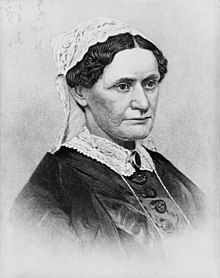Eliza McCardle Johnson
Eliza Johnson | |
|---|---|
 | |
| First Lady of the United States | |
| In role April 15, 1865 – March 4, 1869 | |
| President | Andrew Johnson |
| Preceded by | Mary Todd Lincoln |
| Succeeded by | Julia Grant |
| Second Lady of the United States | |
| In role March 4, 1865 – April 15, 1865 | |
| President | Abraham Lincoln |
| Preceded by | Ellen Hamlin |
| Succeeded by | Ellen Colfax (1869) |
| Personal details | |
| Born | Eliza McCardle October 4, 1810 Telford, Tennessee, U.S. |
| Died | January 15, 1876 (aged 65) Greeneville, Tennessee, U.S. |
| Spouse | Andrew Johnson (1827–1875) |
| Signature |  |
Eliza McCardle Johnson (October 4, 1810 – January 15, 1876)[1] was the First Lady of the United States and the wife of Andrew Johnson, the 17th President of the United States.
Early life and marriage
Born at Greeneville, Tennessee, the only child of John McCardle, a shoemaker, and Sarah Phillips-McCardle, her father died when Eliza was still in her teens.[2] She was raised by her widowed mother in Greeneville, Tennessee. One day in September 1826, Eliza was chatting with classmates from Rhea Academy when she spotted Andrew Johnson and his family pull into town with all their belongings. They instantly took a liking to each other. Andrew Johnson, 18, married Eliza McCardle, 16, on May 17, 1827, at the home of the bride's mother in Greeneville. Mordecai Lincoln, a distant relative of Abraham Lincoln, presided over the nuptials.
At 16, Eliza Johnson married at a younger age than any other First Lady. She was rather tall and had hazel eyes, brown hair and a good figure. She was better educated than Johnson, who by this time had barely taught himself to read and spell a little. Johnson credited his wife for teaching him to do arithmetic and to write, as he had never attended school. She tutored him patiently, while he labored in his tailor shop. She often read aloud to him.
Children
The Johnsons had three sons and two daughters, all born in Greeneville:
- Martha Johnson (1828–1901). She married David T. Patterson, who after the Civil War served as U.S. Senator from Tennessee. She served as official White House hostess in place of her mother. The Pattersons maintained a farm outside Greeneville.
- Charles Johnson (1830–1863) – doctor, pharmacist. At the outbreak of the Civil War, he remained loyal to the Union. While recruiting Tennessee boys for the Union Army, he became the object of an intense Confederate manhunt. He joined the Middle Tennessee Union Infantry as an assistant surgeon; he was thrown from his horse and killed.
- Mary Johnson (1832–1883). She married Dan Stover, who served as colonel of the Fourth Tennessee Union Infantry during the Civil War. The Stovers lived on a farm in Carter County, Tennessee. Following the death of her husband in 1864, she married W.R. Brown.
- Robert Johnson (1834–1869) – lawyer and politician. He served for a time in the Tennessee state legislature. During the Civil War, he was commissioned colonel of the First Tennessee Union Cavalry. He was private secretary to his father during his tenure as president. He became alcoholic and committed suicide at age 35.
- Andrew Johnson, Jr. (1852–1879) – journalist. He founded the weekly Greeneville Intelligencer, but it failed after two years. He died soon thereafter at age 27.
First Lady of the United States
She supported her husband in his political career, but had tried to avoid public appearances. During the American Civil War, Confederate authorities ordered her to evacuate her home in Greeneville; she took refuge in Nashville, Tennessee.
A few months later after her husband became president, she joined him in the White House, but she was not able to serve as First Lady due to her poor health from tuberculosis. She remained confined to her bedroom there, leaving the social chores to her daughter Martha Johnson Patterson.[1] Mrs. Johnson appeared publicly as First Lady on only two occasions—at a reception for Queen Emma of the Kingdom of Hawaii in 1866 and at the president's birthday party in 1867.
Death
After episodes of tuberculosis, Eliza died on January 15, 1876, at the age of 65 in Greeneville, Tennessee. She survived her husband by five and a half months.[2]
References
- ^ a b "Andrew Johnson: Impact and Legacy". Miller Center of Public Affairs, University of Virginia. Retrieved July 8, 2016.
- ^ a b Ford, Lynne E. (2010). Encyclopedia of Women and American Politics. Infobase Publishing. pp. 259–260. Retrieved July 8, 2016.
External links
- 1810 births
- 1876 deaths
- 19th-century American people
- 19th-century women
- Andrew Johnson
- Andrew Johnson family
- First Ladies and Gentlemen of Tennessee
- First Ladies of the United States
- People from Greeneville, Tennessee
- Presidency of Andrew Johnson
- Second Ladies of the United States
- Spouses of members of the United States House of Representatives
- Spouses of United States mayors
- Spouses of United States Senators
- People from Washington County, Tennessee
